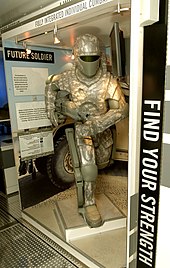Future Force Warrior
The Future Force Warrior (FFW), formerly called Objective Force Warrior , was part of the Future Combat Systems project of the United States Army . It should enable the infantryman to act as part of the military global information grid . At the time, it was the American part of NATO's Soldier Modernization Program .
The Future Force Warrior System was due to be introduced in the US Army in 2010 and cost $ 3 billion by then. It should increase the soldier's survivability, assertiveness and networking ability on the battlefield of the future. Among other things, this should be achieved through more modern and lighter equipment.
The Future Combat Systems program was canceled by Robert Gates on June 23, 2009 , which also marked the end of the Future Force Warrior. Parts of the project were used for the successor program Brigade Combat Team Modernization .
equipment
Headgear subsystem
The headgear subsystem was the electronic 'brain' of the Future Force Warrior. It should contain tactical maps and routes and serve for wireless communication with the other units of the Future Combat System . This should give the individual soldier a 360 ° overview of the battlefield , which should be shown in a small fold-down display . The headgear subsystem should be protected from the effects of light weapons .
Combat Uniform Subsystem
The FFW project also aimed to improve full body protection from projectiles and fragments. The new equipment was designed to protect the upper arms, upper legs, and torso . The body armor was made of modern fibers such as Kevlar , but also included ceramics . In addition, there are considerations in the army command to replace the recently introduced Army Combat Uniform with Multicam , as this sometimes has qualitative deficiencies and geographically only has very limited camouflage properties.
Weapons subsystem
A new standard weapon for the US Army is not in sight in the foreseeable future. Originally, a pistol-like weapon was planned for the Future Force Warrior program, which should fire guided 15 mm projectiles. In the vicinity should be 4.6 mm high-speed bullet to be used in only 2.5 kg of total mass . The Crye Associates Modular Rifle (MR-C) presented afterwards also only existed in mock-ups . With a rate of fire of 900 rounds / min, this weapon should fire 6.8 mm caseless ammunition from a 45-round magazine.
A completely new approach was taken with the XM25 , which fires programmable ammunition like the painted OICW rifle, but no longer contains any kinetic components for self-defense.
In addition, the Lightweight Small Arms Technologies program has been running since 2004 , the aim of which is to develop a new family of infantry weapons.
By networking in the Future Combat System, it should in principle be possible for every soldier to request mortar , artillery, air support or missiles from the NLOS-LS and, if necessary, to direct them to the target. It should also be possible to use other units of the system, such as the MULE robotic vehicle . A squad of Future Force Warriors should carry a Class I UAV and a SUGV with them for reconnaissance .
Warfighter Physiological Status Monitor Subsystem
The WPSM should include sensors built into the suit to monitor the physiological and medical condition of each soldier. The sensors should measure heart rate , body temperature , blood pressure , breathing , stress, and posture. If necessary, the WPSM should relay the data to the commanders or paramedics if the soldier has been wounded or is fatigued.
Micro-climate conditioning subsystem
This mini air conditioner should be incorporated into the life-saving layer of the combat suit. The liquid flowing through small tubes there could heat or cool with an output of 100 watts. The system had a total weight of 1.75 kg.
Power subsystem
The power subsystem should enable 24-hour autonomous assignments, as well as 72-hour assignments in a team. The energy should be generated by a micro gas turbine with 2 to 20 watts, hydrocarbons served as fuel. In addition, accumulators should be available as a reserve for three hours of operation.
future

Further, even more revolutionary technologies were planned for the future, such as an exoskeleton suit or intelligent body armor.
Individual evidence
- ↑ Andrew Feickert, Nathan Jacob Lucas: Army Future Combat System (FCS) “SpinOuts” and Ground Combat Vehicle (GCV): Background and Issues for Congress ( Memento of the original from February 3, 2014 in the Internet Archive ) Info: The archive link became automatic used and not yet tested. Please check the original and archive link according to the instructions and then remove this notice. (English, PDF, 212 kB). In: Congressional Research Service dated November 30, 2009. Online at assets.opencrs.com.
Web links
- Manufacturer General Dynamics ( Memento from November 21, 2007 in the Internet Archive )
- Future Force Warrior Infantry Combat Suite under Defense Update
- Spiegel Online: High-tech combat suit from the ghost town
- Crye Associates Developer Company: Products
- Markus Becker: New military technology: This is how the soldier of tomorrow fights . SpiegelOnline from August 17, 2011.
